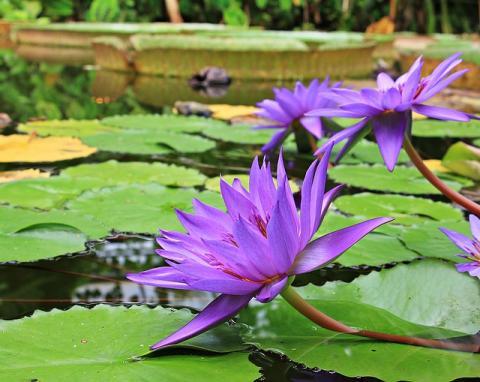
Have you ever wanted to meditate but didn't feel you could accomplish the task? Maybe your mind wouldn't stop jumping from thought to thought or you couldn't sit still for more than a few minutes without getting distracted? Perhaps you don't feel you can make time to meditate or it feels too boring to you. Whatever the reason for avoiding the meditation pillow up until now, fear not - I am about to give you 5 easy ways to meditate – step-by-step - so you can reap the unending rewards from such a practice right away.
In yogic texts like the Hatha Yoga Pradipika by Swami Svatmarma and the famous yogic Upanishads, meditation is described as one of the final steps toward reaching Nirvana/Samadhi and is known as Dhyana. This step is normally reached after practicing various other preparatory techniques such as breathing (pranayama), postures (asanas), cleansing practices (shatkarmas), withdrawal of the senses (pratyahara) and finally Dharana – concentration or sustained attention which lasts for an extended period of time. Understanding all of these steps is certainly a more mental approach to the practice. Trying to approach meditation following a set of prescribed “rules” can sometimes even impede the results you get. Meditation is really just the ability to sustain focus on something for more than a minute (60 seconds) and then to repeat that sustained focus again and again. Here are a few ways to go about it:
1. Trataka – or Candle Gazing
One of the simplest ways to begin meditation practice is to use a point of focus, in this case, a candle flame. Candles are great because we are naturally attracted to watching fire jump around. Using a candle as a point of focus works not only as a meditative tool, but also doubles as a cleansing practice and is one of the Shatkarmas described in the ancient Hatha Yoga Pradipika text. Trataka helps to cleanse the eyes and cranium area making the mind and sense organs ready to go deeper into the practice. It is easy to do and even pleasurable. Here is how to proceed:
Step 1: Obtain a candle with a visible flame
Step 2: Set up the candle at arm-length distance at the height of your forehead center
Step 3: Turn down the lights or do this practice at night so you have only the flame to grab your attention
Step 4: Start by staring at the part of the flame above the wick that is solid and bright
Step 5: Keep staring until you feel your eyes about to water – do not strain
Step 6: Close the eyes and stare at the reverse image impression left by the flame behind closed eyes until the image dissolves (eventually this becomes the longest and most beneficial part of the practice)
Step 7: Repeat the practice 5 times
2. Walking Meditation
A popular Buddhist practice, walking meditation is perfect for this day and age when everyone is busily going this way and that. If you walk anywhere regularly – to work, the store, school, friends’ homes, or leisure outings – this meditation practice might be perfect for you. The only thing it takes is presence of mind and the awareness to shift from “regular walking” to meditative walking. Here's how:
Step 1: Notice you are walking
Step 2: Become aware of the weight of your feet against the ground and the pressure of the Earth beneath your feet
Step 3: Let all other thoughts slip away as you become fully present with each and every step
Step 4: Notice the air against your face and skin
Step 5: Feel your clothing touching your skin
Step 6: Allow the sights and sounds to fill your senses fully
Step 7: Even begin to count each step, allowing no other thoughts of past or future to enter in
Step 8: Continue for at least the distance of your walk
3. Japa Meditation
The word “japa” means repetition. It is one of the simplest and easiest to measure meditation practices as it generally requires a mala – or string of beads. Choose a mantra or simple word like “love,” “yes,” “OM” or a longer phrase like “I Am Love” or “Om Nama Shiviah” which you will repeat for each bead. By using japa, and filling the mind and thoughts with a single sound or phrase it makes it impossible to think about anything else, thereby freeing you up to experience the magic of meditation through japa.
Step 1: Find a place where you can sit with no distractions for 5-10 minutes
Step 2: Light a candle or stick of incense in order to “set the stage” for a meditative feel
Step 3: Sit comfortably, cross-legged or in a chair, holding your mala
Step 4: Starting at the meru, or top-knot in a string of beads (generally tied off with some sort of signifier), chant one sound for each bead
Step 5: Chant the mantra or word out-loud or quietly to the self, repeating for every bead
Step 6: Continue 1-2 rounds of beads
Step 7: End with the sound of “OM” chanted 3 times for completion or a short prayer of gratitude
4. Cleansing Shower Meditation
The shower is a fantastic place and space in which to meditate. You are alone, usually left without distraction for at least 5-10 minutes and it is generally quiet, save the sound of the water running down the drain. Meditation thrives in this environment, as long as you can make a deal with your mind to stay out of the picture - “just this once.” By qualifying it in this way, the mind can usually lay to rest and give you space to simply “be” - which is the point of meditation anyway.
Step 1: Make the intention to become present with each and every moment during shower time
Step 2: Listen to the sound of the water running down the drain and take in the scene – filling all your senses
Step 3: Step into the water and consciously FEEL the water running down over your body
Step 4: Allow the water to wash away all aspects of life, thoughts, beliefs, worries that are not serving you at present – just briefly allow your mental space to scan your life's contents at present and “see” in your mind's eye - unwanted elements rushing off you and down the drain
Step 5: Feel the cleansing power of water – feel connected to all the water everywhere
Step 6: Stand in surrender and let yourself be washed clean, listening only to the water and your breath
Step 7: After you are finished, turn off the shower and feel the water on your skin, the sensation of the towel in your hands and on your body, breathe in a sense of renewal and freshness
5. Listening Meditation
In this meditation you are taking the opportunity to meditate every time you are interacting with another person, not in a way that ignores them and sends you deeper into self-absorption, but in a way that listens to them even more. So often when we listen to another person talk we are not really listening. Most of the time we have our own inner dialogue going on that is either already answering their queries, or is jumping forward or backward in time fulfilling other inner needs – be they escape, fears or dreaming. In this meditation we are practicing what happens when we truly listen to another being. When we do this we may find that time and space open up and something miraculous presents itself to us in the space in-between.
Step 1: Recognize you are in conversation with another human being
Step 2: Drop all agenda and expectation
Step 3: Allow their words to fill your mind
Step 4: Feel the space around them and between the two of you and recognize it as holy
Step 5: Listen to every word and feel the way the words and expressions hit your ears, your heart and your mind. Try not to fill the space with interpretations. Simply listen.
Step 6: Breathe with them and feel an invisible energy moving back and forth between your two hearts, your two throats, your two minds. Feel the communion
Step 7: When there comes a space for you to speak – truly listen to what spontaneously drops in for you to say in reply, if anything
Step 8: Give thanks for the opportunity to connect with another human being in this way
Step 9: Reflect later on your listening meditation and what you learned, experienced and heard
Meditation is a powerful tool for getting present and tuning into the power accessible in each and every moment. It is a way to access deeper states of consciousness and to hear the silent promptings of intuition and spirit in your life. It doesn't have to be a dull or boring practice and, as you can see, there are a variety of ways to practice meditation that can be fun and enlightening and can fit easily into your regular, everyday schedule.
Meditation is more than a practice, it is a way to approach reality and the day-to-day with presence and peace of mind. Now you know 5 easy ways to meditate, step-by-step, which can make your life more fulfilling and magical. I'd love to hear which one you like the best!







